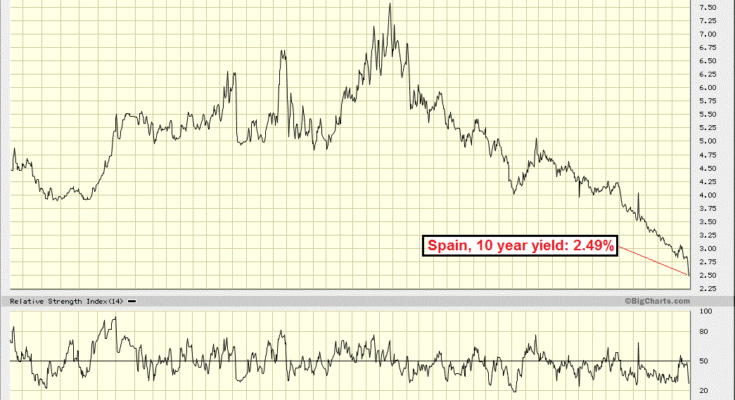Dysfunctional Bond Markets – A Comparison of Yields
Below we show the 10 year government bond yields of three countries: Spain, Japan and the United States. Also shown are budget deficits and total public debt as a percentage of GDP. It would actually make more sense to look at deficits as a percentage of tax revenues. The comparison of debt to GDP seems not to make a lot of sense intuitively, as governments cannot pay their debts out of ‘GDP’, but only out of tax revenues (note also that there are slight differences in the GDP calculations).
Anyway, the point is mainly to compare the three countries, as both Spain’s and Japan’s bond yields essentially reflect zero risk at this point. In fact, investors seem to assume that the combination of inflation risk and default risk in Spain and Japan is lower than in the US, which strikes us as slightly absurd, if only for “technical†reasons. An overview of annual CPI rates of change is shown as well. Also included above the bond yield charts are the credit ratings assigned by the three big credit rating agencies (in this order: S&P, Moody’s, Fitch).
Spain
Spain’s credit ratings:
|
SPAIN |
BBB |
Stable |
Baa2 |
Positive |
BBB+ |
Stable |

Spain’s 10 year note yield has just plunged to a new low at 2.49%. This is quite an astonishing development – click to enlarge.
Â

Spain – budget deficit as % of GDP – there has been improvement, due to a slight economic recovery and government spending being frozen (at a very high level) – click to enlarge.

Spain: public debt-to-GDP ratio – this ratio has grown by leaps and bounds since 2009 – click to enlarge.

Spain, CPI: consumer price inflation is reportedly very low in Spain at present, so if no bond default risk or euro break-up risk is assumed to exist, the current low yield on government bonds can be partly explained – click to enlarge.
Japan
Japan’s credit ratings:
|
JAPAN |
AA- |
Negative |
Aa3 |
Stable |
A+ |
Negative |

Japan: 10 year JGB yield. Currently this yield is almost 280 basis points below the most recently reported annual inflation rate of 3.4% (CPI) – click to enlarge.

Japan: budget deficit as % of GDP. There is no Japanese term for ‘budget surplus’, and if there is one, it has been forgotten – click to enlarge.
Â

Japan: public debt-to-GDP ratio. This is a rather awesome statistic. As we have previously discussed, Japan’s public debt has long acquired all the hallmarks of a giant Ponzi scheme – click to enlarge.

The ‘success’ of goosing inflation in Japan. Lately it looks like Mr. Kuroda has been almost a bit too successful, but money supply growth actually remains fairly tame thus far. However, one must keep in mind that enough cumulative money supply growth has occurred in the past to allow prices to permanently increase on account of contingent triggers such as the yen’s recent decline in the forex markets – click to enlarge.

